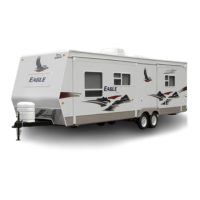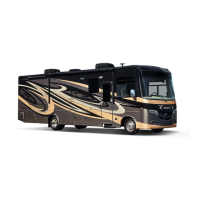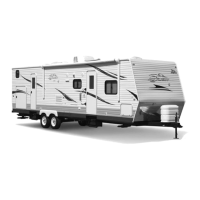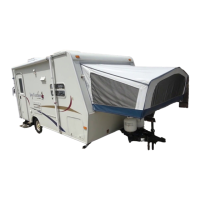CLASS C MOTOR HOME SECTION 6 – 30 AMP ELECTRICAL SYSTEM
6-7 GH/M
Never depress the momentary battery disconnect switch for longer than 1 second.
Depressing and holding the switch down will disable the battery disconnect
solenoid. Should this occur the main ground cable for the house batteries must be
removed for 1 minute to re-enable the solenoid operation.
H
OUSE BATTERIES
Your motor home has many 12-volt DC loads. When combined, their total load
requires more power than the converter can produce. High demands for 12-volt
power can be met by the house batteries for a limited period of time. The 12-volt
DC electrical system is designed for usage with Group 27 deep cycle batteries.
The batteries for the house section of the motorhome are usually referred to as
house (or coach) batteries.
The house batteries are factory-installed to provide temporary 12-volt power when
120-volt power is not available to operate the power converter. When drawing
energy from the batteries, remember that there is a limited amount of power
available before the batteries need to be recharged.
To recharge the house batteries
When the engine is running, the alternator will automatically charge the house
batteries through the auxiliary start solenoid. When parked at a campsite and
plugged into shore power the power converter will automatically charge the
batteries. Complete charging may take several hours and depends upon battery
condition and the amount of power consumed by the 12-volt devices operated
during the charging period.
Dry camping
Consider the charge condition of the house batteries when dry camping. When the
house batteries are not being recharged and power is being drawn from them,
they will eventually discharge. A battery will discharge faster as its voltage gets
lower. Plan your 12-volt electrical use accordingly.
A fully charged 12-volt battery will read 12.7 volts DC and have a specific gravity
of 1.265 at 80°F (32°C). The house batteries are considered discharged at 11.8
volts and “dead” at 11.65 volts.
When battery voltage drops below these lower thresholds permanent battery
damage may occur.
Typically, a deep cycle battery has an amp-hour rating of 75-100 amps. If you run
the furnace and refrigerator simultaneously, you will be using approximately (12.0
+ 3.0) 15.0 amps per hour. This does not include any 12-volt lights, water pump or
any other 12-volt component.
If the furnace and refrigerator in the above example operated constantly, a
75 amp-hour battery would become fully discharged in 5 hours (75ah / 15a
= 5h).
WARNING
Always wear eye protection when working with batteries. Keep sparks,
cigarettes and flames away from the battery as the battery may explode. Do
not use a booster battery or any other power source that has an output that
exceeds 12-volt. Use adequate ventilation when charging or using the battery
in

